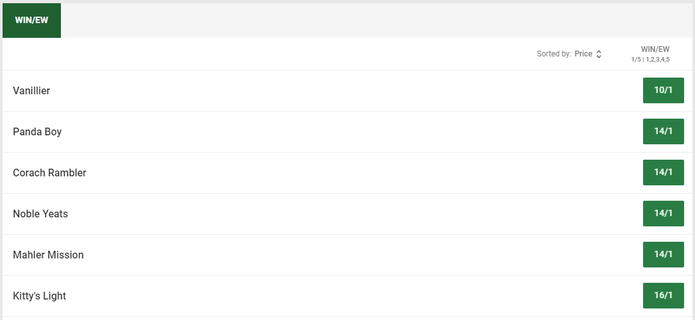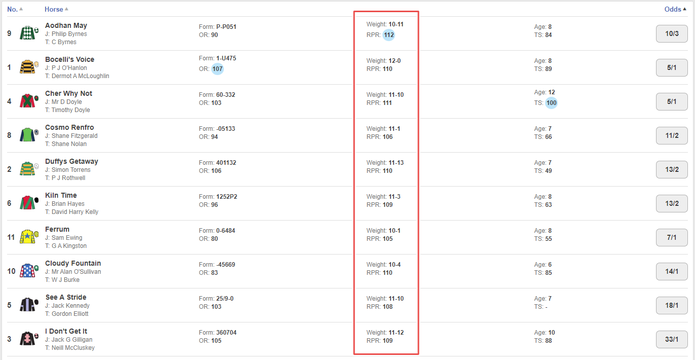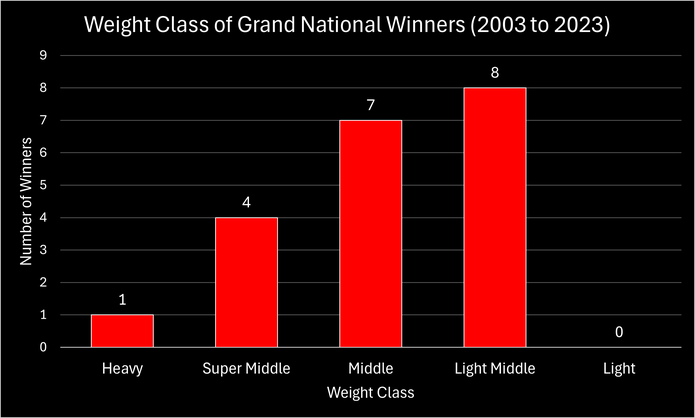![]() Around 6-8 weeks prior to the Grand National each year, the trainers and connections of horses with a ‘soft’ entry into the race enjoy a slap-up lunch as they find out how their horse has been treated by the handicapper.
Around 6-8 weeks prior to the Grand National each year, the trainers and connections of horses with a ‘soft’ entry into the race enjoy a slap-up lunch as they find out how their horse has been treated by the handicapper.
Some will be pleased by the outcome of the handicapping process: their horse will be ‘well treated’, i.e. given a lighter weight to carry than they might have been expecting. Others will be left fuming by the handicapper’s rating – famously when Tiger Roll was denied a hat-trick bid at the Grand National by a heavy 11st 4lb weighting, owner Michael O’Leary turned the air blue.
“Since we are responsible for the welfare of Tiger Roll, we must protect him from the idiotic opinion of this handicapper,” O’Leary commented.
Not everybody will be left pleased by the work of the handicapper, with their work having significant ramifications for the outlook of the race. Some owners will withdraw their horse from the race if they don’t agree with the weighting – as O’Leary did with Tiger Roll.
This handicapping process also helps to shape the Grand National betting market too – punters lost interest in the 2024 ante-post favourite, Corach Rambler, when he was assigned 11st 2lb – Vanillier, who lost the 2023 edition by around two lengths to Corach Rambler, was assigned 10st 8lb and therefore became the new overnight favourite.

One of the questions that newcomers to racing ask – and it’s a discussion point that has seasoned veterans of the sport also scratching their head – is does weight really matter in horse racing? Won’t the best horses simply overcome their handicap anyway?
What is a Handicap in Racing?

Certain big races, like the Cheltenham Gold Cup, have a set weight – all of the horses will carry 11st 10lb.
But in handicap racing, the idea is to add weights to the stronger horses in order to create a level playing field.
The job of the handicapper is to decide how much added weight will be assigned to each horse to create a fair race. To do so, they study videos of a horse’s past runs, analyse their sectional times and quantify their ability by comparing them to other runners in a field.
At the end of this process, they will draw up a list of weights to create a utopian handicap race, in which – theoretically – all of the entries have a similar chance of winning as each other.
The weight of the jockey and their equipment is applied to the calculation, before lead weights are fixed to the horse’s saddle to meet the handicapper’s weighting for each horse.
You can see the handicap for each horse denoted on the racecard, where applicable, while you may also see OR – this stands for ‘official rating’, and is essentially the basis from which the handicapper has decided the weight for each runner in the field.
In theory, the higher the OR the stronger the horse is – but also the heavier the weight they will carry in a race.
How are Racing Handicaps Calculated?

Some handicap races are assigned a specific ratings band – meaning that only horses with an official rating in that range can be entered.
So, if the handicap race is for those rated 90 to 110, only such horses can be declared – with the handicapper using the relative OR of those entered to calculate the weight that they will carry.
An 110-rated horse will be asked to carry top weight of 11st 10lb, with the rest of the field then handicapped using that baseline. So, a horse rated 105 will carry 5lb less at 11st 5lb, with a 102 rated horse handicapped at 11st 2lb, a 100 rated horse at 11st and so on.
The job for punters is to decide which horses have been assigned a fair handicap relative to their ability – remembering that the handicapping process is rarely an exact science, and that the handicapper can make ‘mistakes’ in their ratings.
The general consensus is that 1lb in weight is worth around one length on the grass, so if Horse A beat Horse B last time out by three lengths but was carrying five lbs less, the idea is that Horse B might be the faster animal if they were carrying the same weight.
However, that is something of a simplification of a complex puzzle for the handicapper to solve.
Do Heavier Horses Run Faster?

Although they are truly remarkable animals, horses are like any other species – generally speaking, the more weight they carry then the slower they will be.
That is a very generalised statement, and doesn’t account for natural variations – horses can be sizable due to muscle mass, which in turn helps them to run fast. There’s absolute no guarantee than a naturally lighter horse will be a fast runner, either.
When it comes to handicapping, it’s clear that a higher-grade performer can more easily shoulder the burden of a weight gain than a weaker runner, whose speeds and jumping ability will plateau as soon as they reach a certain rating.
The handicap system has been used in racing for decades – enough time for mathematically worthy data to have been recorded. Those stats confirm that weight, of itself, has little bearing on how fast a horse can run.
Instead, their natural, genetic ability to run fast and jump well will have the greatest bearing, with the outcome of handicap races largely dictated by the accuracy of the handicapper (and the many variables that go into determining how a horse race plays out).
The data, meanwhile, suggests that the top weight in a handicap field has a lower strike rate compared to those with a more agreeable mark. In handicap races for three-year-olds or older on the Flat, the top weight wins on average around 18% of the time – a healthy success rate for those laying them, if nothing else.
Even though heavier horses are typically higher rated, classier animals out on the track, there is a limit to the weight that they can successfully carry – as the data confirms.
Is It Better for a Racehorse to Be Heavier or Lighter?
The different race types can also play a part in determining the success rate of the handicapper. Imagine you were to race Usain Bolt over 100 metres – you probably wouldn’t fancy your chances very much! Now imagine that Bolt had two car tyres strapped around his waist….you’d suddenly start to feel a little more positive about your chances.
In the same circumstances, if you raced Mo Farah over 26 miles and he had two tyres strapped to him, it’s quite likely that he would still defeat you – the longer the race distance, the more likely it is that the stronger performer will win.
However, that’s not always the case. To offer some kind of context, here’s the weights of the winning horses from 20 editions of the Grand National between 2003 and 2023. Remember: the higher the weight, the better (in theory) the horse. For ease of categorisation, we’ve assigned the horses boxing-style classifications:
- Heavy – 11st 7lb to 11st 12lb
- Super Middle – 11st 1lb to 11st 6lb
- Middle – 10st 9lb to 11st
- Light Middle – 10st 3lb to 10st 8lb
- Light – 9st 10lb to 10st 2lb
Is it better for a racehorse to be heavy or light? In the context of the Grand National, historically the answer has been….neither!

In the 20 years of our analysis, 19 of the winners fitted into our middle three weight categories – suggesting that the very lightest horses simply aren’t good enough to win such a challenging race, while those carrying the heaviest handicap mark, while clearly highly-rated horses, simply have too much to do over such a gruelling distance and set of obstacles.
If you’re looking for the sweet-spot handicap for a Grand National winner, it’s somewhere in the region of 10st 3lb to 11st – although even within that band, there will be horses that have been over and under-rated by the handicapper.
Of course, the Grand National is just one race of a mammoth National Hunt season, so it’s a very small sample size. Over shorter distances and easier flights of fences, we would expect the numbers to be skewed slightly in the direction of the heavier (i.e. higher rated) horses.
Is It Better for a Horse to be Going Up or Down in the Weights?
The stats for this particular question have plenty of grey areas, because it’s not a level playing field when a horse shifts weight from one race to the next – next time out they may be stepping up/down in grade, they may be running at a track for the first time or on going that isn’t entirely suitable for them.
But a research study by FlatStats revealed that horses with added weight, who the handicapper fancies on the back of their last run, generally produce marginally better results than a horse eased back in the weights.
Win ratio of horses up in weight next time out – 10.22%
Win ratio of horses down in weight next time out – 8.63%
Again, it should be stressed that there are many different variables that go into those statistics, but a sample of more than 200,000 horses at least offers plenty of clarity.
The best option for punters is to look out for horses that can be described as progressive ‘improvers’ – those shifting gradually up through the weights, but who have shown an ability to offset such a gain with a strong performance nonetheless.
How Do You Know When a Horse Is Going to Win?
There is simply no way of knowing how a horse race will play out before the off, and without doing plenty of homework such predictions become even more difficult for handicap races.
However, another type of race can be easier to predict. Some renewals have what can be described as ‘flat weight’ or ‘same weight’ rules – for example, all of the horses in the Cheltenham Gold Cup will carry 11st 10lb.
Now, we know that the Gold Cup is the cream of the crop when it comes to three-mile chasing, which is why the race is assigned Grade 1 status.
So, punters already have an idea of how to ‘handicap’ the Gold Cup themselves: we’re looking for horses that have won in Grade 1 company, over three miles, while carrying 11st 10lb or more. Those that tick these boxes should have a chance of winning the Gold Cup, right?
Let’s take a look at the previous five editions of the Gold Cup for evidence:
Gold Cup Winners (2019 to 2023)
| Year | Winner | Prior G1, 3m+, 11-10 Wins? |
|---|---|---|
| 2023 | Galopin Des Champs | Yes |
| 2022 | A Plus Tard | Yes |
| 2021 | Minella Indo | Yes |
| 2020 | Al Boum Photo | Yes |
| 2019 | Al Boum Photo | No |
In the 2023 Gold Cup, Galopin Des Champs fit the bill. He’d won the Irish Gold Cup carrying 11-10 over three miles at Leopardstown, plus the Irish Mirror Novice Hurdle back in 2021.
The horses that finished second and third, Bravemansgame and Conflated, also ticked the boxes with their victories in the King George VI Chase and Savills Chase respectively.
A Plus Tard was also a Savills Chase winner prior to his Gold Cup triumph in 2022, while a second place in the race a year prior also franked his claims. Again the second and third place finishers in that 2022 Gold Cup – Minella Indo and Protektorat – also fit the profile of Grade 1 winners over three miles while carrying 11st 10lb or more.
The 2021 Gold Cup winner, Minella Indo, also fits the profile – albeit with caveats. He won at the grade and distance while carrying 11-10 in the Irish Daily Mirror Novice Hurdle, but not over fences. A fall when well placed in the Savills Chase ended those hopes, although victory in a Grade 2 chase at Navan while carrying 11-10 over three miles at least offered some clues.
The 2020 Gold Cup champion, Al Boum Photo, scores an immediate free pass – he had won the Cheltenham Festival showpiece a year earlier! Ahead of the 2019 edition, the horse hadn’t met our criteria, although he might have done but for a colossal error from jockey Paul Townend in the Champion Novice Chase at Punchestown.
Al Boum Photo led the race and was travelling well, before Townend inexplicably ‘ran out’ of the final fence to disqualify himself and the horse. The Irishman later revealed he thought that the field was to bypass the last obstacle, making the wrong call at the last split second.
So we can say with some confidence that winning a Grade 1 race over three miles, while carrying 11-10 or more, is a very handy marker of success in the Cheltenham Gold Cup. There’s absolutely no guarantees, of course, but it’s proof positive that punters can use weights and handicaps in order to better educate themselves ahead of making their selections.
There are many other races on the National Hunt calendar too where a certain profile of horse continues to thrive, so using these nuggets of gold can be a fruitful exercise – who said weight in horse racing doesn’t matter?